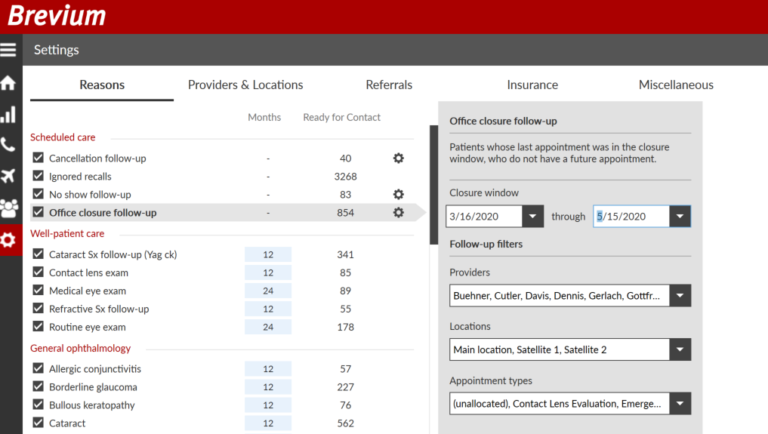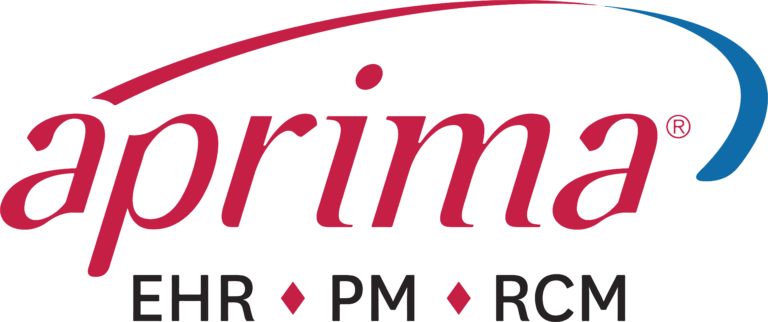The Brevium Blog

Guide to Getting Started with Reactivation Appointments
How to get patients to come back? How to increase patients in your clinic? How to engage patients in their care? How to reactivate old patients? How to regain customer trust?
These are only a handful of questions that practices search to find strategies and techniques for re-engaging lost patients and driving appointment volume with patient reactivation. Patient attrition has always been a natural outcome of running a business or medical practice and in many cases, patient loss is unavoidable. However, many healthcare practices do not have effective patient reactivation plans in place to re-engage these patients despite acknowledging that letting their patients remain inactive is unwise and can result in missed opportunities and lowered engagement. The following comprehensive guide will help your practice unlock the most effective patient reactivation strategies and techniques that will not only re-engage lost patients in their healthcare journeys but result in significant growth and boosted revenue for your business.
Understanding Patient Reactivation
To effectively implement patient reactivation into your practice workflow, you must first understand what the process accomplishes and how it differs from other strategies used to engage patients. Often mistaken for patient reminder or patient recall, patient reactivation is the process of identifying lost or overdue patients and using strategic outreach to re-engage them for essential care.

Generating patient reactivation appointments is essential for the health and success of both your overdue patients and your business; without it, practices not only miss out on the untapped revenue streams dormant with their inactive patients but allow them to slip through the cracks and remain there—ultimately, missing out on essential treatment and screenings vital for living and maintaining a healthy life. The following are reasons that all medical practices should prioritize customer reactivation as part of their patient engagement strategies:
How Patient Reactivation Benefits Patients:
- Keeps them compliant with needed treatment.
- Combats long-term or chronic disease or disability.
- Boosts patient satisfaction and overall healthcare experience.
- Improves overall health of patient population.
- Re-energizes patients to become proactive participants in their own care.
How Patient Reactivation Benefits Practices:
- Fuels organic practice growth.
- Drives revenue from previously untapped sources.
- Cheaper to reactivate former patients than market to new ones.
- Increases appointment volume, contributing to full provider schedules.
- Converts patients back into loyal, repeat customers.
Preparing for Patient Reactivation Campaigns
Though many practices are eager to dive into patient reactivation and start reaping the benefits of their efforts, there are steps they must take to ensure the success of their campaign. Patient reactivation can be a huge undertaking for many practices because of staffing limitations and resource constraints. With many different moving parts in the reactivation process, it’s extremely important your staff are all on the same page and have the knowledge and tools to be successful. Here are four ways you can prepare your practice before starting a patient reactivation campaign:
Setting Goals & Expectations
The primary goal of patient reactivation is to re-engage lost patients and convert them back into loyal and satisfied customers. However, establishing specific goals and expectations is critical for your reactivation campaign’s success because you not only need to know who to engage and how, but also what results to look for and how to make sense of the data generated from your efforts. Are you looking to create and access another revenue stream? Are you wanting to see more of a specific patient type—perhaps those who are high-risk or high-value? Are you trying to increase appointment volume and keep provider schedules full? Your decided goals will eventually be the driving force behind your campaign and will ultimately determine the patients you target first, strategies used for re-engagement and the metrics you track to measure success.
Prepare Your Staff
Providing your staff with proper tools and training is vital for the success of your customer reactivation campaign; without these essentials, you set up your staff for failure. Equip your staff with the necessary resources to implement effective patient reactivation, including educating them on the best strategies and practices for patient engagement, communication and follow-up. Likewise, your staff will need to be prepared to answer the phone when patients call to schedule appointments, ask questions or seek additional information. Empowering your staff to handle different aspects of your patient reactivation campaign through proper training leads to not only optimized practice workflows and increased staff satisfaction, but also enhanced patient outcomes and improved patient experiences. There are many ways you can prepare your staff for effective patient reactivation:
- Familiarize them with the goals and objectives of the reactivation campaign.
- Provide them with training on the entire patient reactivation process, especially if they are using a software to assist their efforts.
- Set aside time in staff workflow to follow-up on reactivation attempts and prepare them to receive an influx of calls from patients looking to schedule appointments or seek additional information.
- Provide them a script on how to answer questions over the phone. Asking the right questions will help your staff determine what type of contact the patient received, if they need to schedule an appointment and who they need to schedule with (doctor, PA, etc).
Identify Inactive Patients
The first step in the patient reactivation process is identifying which patients are lost or overdue for essential care. Depending on the patient’s condition or diagnosis, some patients may be overdue for treatment sooner than others. The process may seem outwardly simple; however, practices utilizing manual workflows may find that identifying inactive patients and their care needs is a laborious process that requires staff to sacrifice additional time, money and resources to finding lost patients and determining who is due for care. And if these patients don’t respond, staff will have to continue with additional outreach and follow-up. Consider using a patient reactivation software like Brevium that would optimize this process by using its patented software to mine your practice management system to find and contact lost patients for you—eliminating the need for countless staff hours that could be focused elsewhere.
Segment Patients
Practices too often decide to start their patient reactivation campaigns without segmenting their inactive patients into manageable groups and instead, attempt to reactivate all their inactive patients at once. This strategy is not just inadvisable because it can quickly overwhelm your staff, but also because generic reactivation isn’t tailored to help you achieve your specific goals and objectives for patient reactivation. Rather, patient segmentation helps your practice both deliver personalized care to patients with similar needs and conditions while also working toward your growth goals. The following are the three common ways Brevium customers segment patients to achieve reactivation goals:
- Using ICD-10 and CPT codes to reactivate patients with specific diagnoses who will likely need surgical procedures.
- Reactivating patients to fill a specific doctor or location’s schedule.
- Targeting patients with high-risk or threatening conditions.
Implementing Effective Patient Reactivation
Though most healthcare professionals agree that patient reactivation and retention is important for maintaining a thriving business, only 30 percent of medical practices utilize effective strategies for winning back lost patients. Many practices instead choose to focus their efforts on new patient acquisition, yet gaining new patients is of little use if you let them slip through the cracks and remain there. We’ve already discussed the important steps to take before starting your reactivation campaign. Here are three strategies that when implemented, will take your patient reactivation efforts to the next level:
Multi-Channel Communication
From small to large healthcare organizations, you’ll rarely see a practice today that doesn’t use a variety of communication channels to contact patients. Whether its phone calls, texts, emails, postcards, social media, or other healthcare information applications, practices use various contact methods to communicate and share relevant information with patients regularly—if not daily. As with other patient engagement processes, your patient reactivation campaign is made possible through an effective outreach strategy; after all, Brevium found in its 2019 ALOHA study that practices who contact their inactive patients at least four to five times using multiple contact methods over an extended period can boost their patient reactivation rates by 81 percent. Luckily, Brevium streamlines this process by not only using primarily automated contact methods but also using multi-channel communication (staff calls, autocalls, texts, emails, and postcards) to ensure the highest reachability with your inactive patients.
Targeted Outreach
Patient reactivation campaigns are at their most successful when practices perform targeted patient outreach. As discussed above, identifying patients ready for reactivation and segmenting them into similar groups before you actively begin the reactivation process will allow your practice to re-engage patients that will help achieve its desired goals and objectives. Consider using a software to help you perform targeted outreach. Brevium allows its customers to build custom templates that changes the wording of the outreach messages. There are four ways to customize your template: diagnosis, provider, location or language. This targeted outreach is especially helpful for practices that have both new and retiring providers.
Utilizing Patient Reactivation Technology
Many practices acknowledge the need for patient reactivation, but do not have the time nor manpower to perform the process effectively. Luckily, modern technology advancements from the past few decades now give healthcare practices the means to streamline tedious processes like patient reactivation, offering comprehensive solutions that hardly require staff to exert any effort. Brevium takes patient reactivation to the next level with its patented data mining software that integrates with your practice management system to identify and target your high-priority patients, resulting in full provider schedules and enhanced patient health outcomes. Keep reading to discover how Brevium revolutionizes patient reactivation and helps practices across the nation experience unparalleled growth and stellar returns from their own patient pools.
Tracking and Analyzing Results
Effective patient reactivation isn’t a one-and-done process, but more like a continuous cycle that involves consistent monitoring, evaluating and adjusting so your practice knows what’s working and where to improve. Your data is a vital tool that provides invaluable insights into the overall effectiveness of your patient reactivation campaign and can empower your team to make educated decisions that will optimize the reactivation process and drive greater results. There are three areas of focus for tracking and analyzing patient reactivation success:
- Monitoring Contact Metrics and Patient Reactivations
When it comes to analyzing the overall effectiveness of your patient reactivation campaign, there are six key metrics that can provide you valuable insight:
- Contacts sent – number of contacts sent to inactive patients.
- Communication channels – communication channels used to contact inactive patients (i.e. staff calls, autocalls, texts, emails, or postcards).
- Patient type – which patients are targeted for reactivation (i.e. according to: ICD-10 or CPT codes, billing codes, insurance carrier, provider, location, no-show/cancellation, last treatment date, etc).
- Appointments scheduled – total number of appointments scheduled only by inactive patients.
- Appointments kept – total number of appointments attended or kept by inactive patients.
- Patient conversion rate – percentage of patients reactivated compared to contacts sent.
While these metrics aren’t the only numbers to track during the patient reactivation process, they are the “headliners” that provide a comprehensive view of your reactivation campaign. These numbers should paint a picture of what strategies are working and those that aren’t, allowing practices to identify areas for improvement and adjust their strategies to achieve favorable outcomes. Consider using a software solution to help your practice not only efficiently track and analyze your constantly evolving patient reactivation data, but also provide a centralized location to access and store reports.

- Analyzing Patient Feedback and Responses
Valuable insights don’t just come from numbers and data—they often come from the patients themselves. Yet, collecting this feedback is only the start. Using patient feedback and responses to drive meaningful change empowers your team to adjust their patient reactivation campaign and craft an experience that consistently leaves patients satisfied. If taken seriously, your patients’ feedback will be an invaluable indicator to how your outreach is being received and will be the touchpoint from where you can adjust your patient reactivation strategy. The following are ways practices collect feedback that can be translated into actionable insights:
- Reviewing responses to automated text messages or monitoring behaviors such as the rate patients respond to messages, ignore them or opt out.
- Feedback directly provided to staff and providers through phone calls, texts or in-person appointments.
- Survey responses conducted in-person, over the phone, via mail or through automated methods such as texts, emails or patient portals.
- Identifying Areas for Improvement
The final step in tracking patient reactivation success is to use the data you’ve collected to gain valuable insight that can help you improve your reactivation strategy. Using your predetermined goals and expectations as a touchpoint, evaluate your patient reactivation metrics and patient feedback for any notable trends. Through this careful evaluation, your practice can access valuable insights that will help refine your patient reactivation strategy and drive better decision-making that will lead to more desirable outcomes.
How Brevium Can Help You Get More Reactivation Appointments
Today’s healthcare industry is one of many that has been positively transformed by technological advancements of the last few decades. With these breakthroughs, medical organizations have the ability to streamline office workflows and deliver higher quality care that enhances their patients’ health outcomes and optimizes practice performance. One of the many patient engagement processes refined by software solutions is patient reactivation—a process that many practices waste time, money and energy trying to do manually. Brevium, the pioneer and leader in patient reactivation technology, is a tool purpose-built to help practices re-engage lost patients and access the revenue dormant from your inactive patient base. Here are three ways Brevium revolutionizes patient engagement and streamlines your patient reactivation process:
- Brevium Connection
The Brevium Connection is a preliminary “audit” of your patient database to determine the number of inactive patients ready for reactivation. This connection is often eye-opening because many administrators don’t realize exactly how many patients are dormant in their database. With an estimated 25 percent of every practice’s patient base lost or overdue, the Brevium Connection becomes an essential tool for not only finding a practice’s inactive patients, but also motivating practices to prioritize patient reactivation efforts.
- Identifying Patients with Data Mining
Brevium’s patented data mining software streamlines the usually tedious process of strategically identifying and reactivating according to patient type. Beyond reactivating patients based on ignored recalls or last visit date, Brevium also uses a combination of unique identifiers such as ICD-10 and CPT codes, billing codes, treatment history, insurance carrier, provider, and more to help practices prioritize its high-risk and high-value patients. Using these parameters, practices can mine for a specific patient type and find the number of patients ready for reactivation instantly. Ultimately, Brevium’s data mining tools allow practices to be in full control of their patient reactivation efforts and maximize returns without dedicating excessive staff time to the process.
- Advanced Reporting
Most practices do not have efficient strategies in place to gather, organize and make sense of the data they collect from their reactivation efforts. Even when practices do attempt to manually generate reports, healthcare data is constantly changing and by the time those reports are ready, the information may be inaccurate. Luckily, Brevium’s advanced reporting tools allow practices to access detailed reports that provide instant insight into the effectiveness of their patient reactivation campaigns. And unlike manual data analysis, Brevium’s reports are always updated, accurate and accessible due to the system’s constant updates and user-friendly dashboard. Though the list is long, some examples of Brevium reports include: patients ready for reactivation, contact attempts, appointments scheduled, appointments kept, patient conversion rate, revenue generated, overall ROI, provider “busyness” report showing statistics on provider availability, and much more.
Brevium Success Stories & Testimonials
With over 18 years of refining its software features, Brevium is the top choice for practices dedicated to enhancing patient care, increasing compliance and boosting revenue through effective patient reactivation strategies. Whether it’s a single-provider practice with one location or a large organization with hundreds of providers and locations, Brevium can transform and grow with your business. Below are a few case studies highlighting how Brevium has transformed healthcare and why medical professionals are looking to Brevium to enhance patient health outcomes and drive organic practice growth:
Platinum Dermatology & West Dermatology: Platinum Dermatology is a physicians services organization notable for its strategic partnerships with top dermatologists across the nation. West Dermatology is a 19 brand, 154 provider dermatology organization that merged with Platinum in June 2023 so they could hand off daily office responsibilities in exchange for prioritizing what mattered most: their patients’ health outcomes. After some persuasion from Grizelda Altamirano, Platinum’s Chief Operations Officer, West Dermatology went live with Brevium in June 2023 and despite the ramp-up process to cover such a massive organization, they experienced stellar returns:
- 32,736 appointments generated and 21,605 patients reactivated, averaging 4,500 reactivated patients per month.
- 24.4x ROI – for every dollar spent on the software, West Dermatology received $24.40 in return.
- $3 million in additional revenue generated from inactive patients alone.
- Achieved results using primarily automated outreach methods, with occasional staff calls.
- Completed six “stitches” through the end of 2023—merging new and old practice management systems to create one seamless file of patient history imperative to the patient reactivation process.
Hillsboro Eye Clinic (HEC): HEC is a nine provider, three location organization with over 50 years of experience delivering exceptional eye care to patients in and around Hillsboro, Oregon—a town 15 miles west of Portland. The group went live with Brevium in February 2021 and experienced incredible results; however, HEC decided to switch to a less expensive reactivation solution in February 2022 and the adverse results were immediate. After almost a year of empty provider schedules and declining revenue, HEC re-started Brevium in December 2022 and according to office administrator Shannon Hunt, the results were instant. The following were the results by the end of January 2024:
- 58x ROI, meaning they receive $58 for every dollar paid to Brevium.
- 4,564 lost patients reactivated, many of which returned for multiple appointments.
- Employed only automated outreach using a combination of autocalls, emails and texts, with autocalls having the highest conversion rate.
Carolina Allergy and Asthma (CAAC): CAAC is a 14-location organization with over 70 years of experience treating patients with asthma, allergy and immunology conditions in and around Charlotte, North Carolina. Looking to reactivate patients who no-showed, cancelled or forgot to schedule a return appointment, CAAC went live with Brevium in January 2022 and experienced stellar returns after only a year of using the software:
- 5,500 lost patients reactivated.
- 37x ROI on office visits alone (not including surgical revenue), meaning CAAC received $37.00 for every dollar paid to Brevium.
- Employed solely automated outreach to achieve results (i.e. texts, emails and autocalls), with 42 percent of patients who scheduled an appointment doing so in response to the autocall.
Conclusion
Most healthcare professionals don’t realize just how many inactive patients are dormant in their databases. With most practices having thousands of overdue patients per provider, implementing the discussed patient reactivation strategies can unlock the hidden potential within your practice and be the difference between a thriving business and one just scraping by. Patient reactivation is understandably a daunting process that has many moving parts; after all, the process is a continuous effort that demands staff time and commitment and requires consistent monitoring to optimize workflows. However, patient reactivation becomes much less intimidating with the help of a patient reactivation software like Brevium—a system purpose-built to streamline the patient reactivation process so practices can focus on what matters most: improving patient health outcomes and driving practice growth. Contact Brevium today to learn more about how the patented technology can help your practice experience unprecedented returns.














